How to Integrate Retail TPM and Foodservice Contract Management?
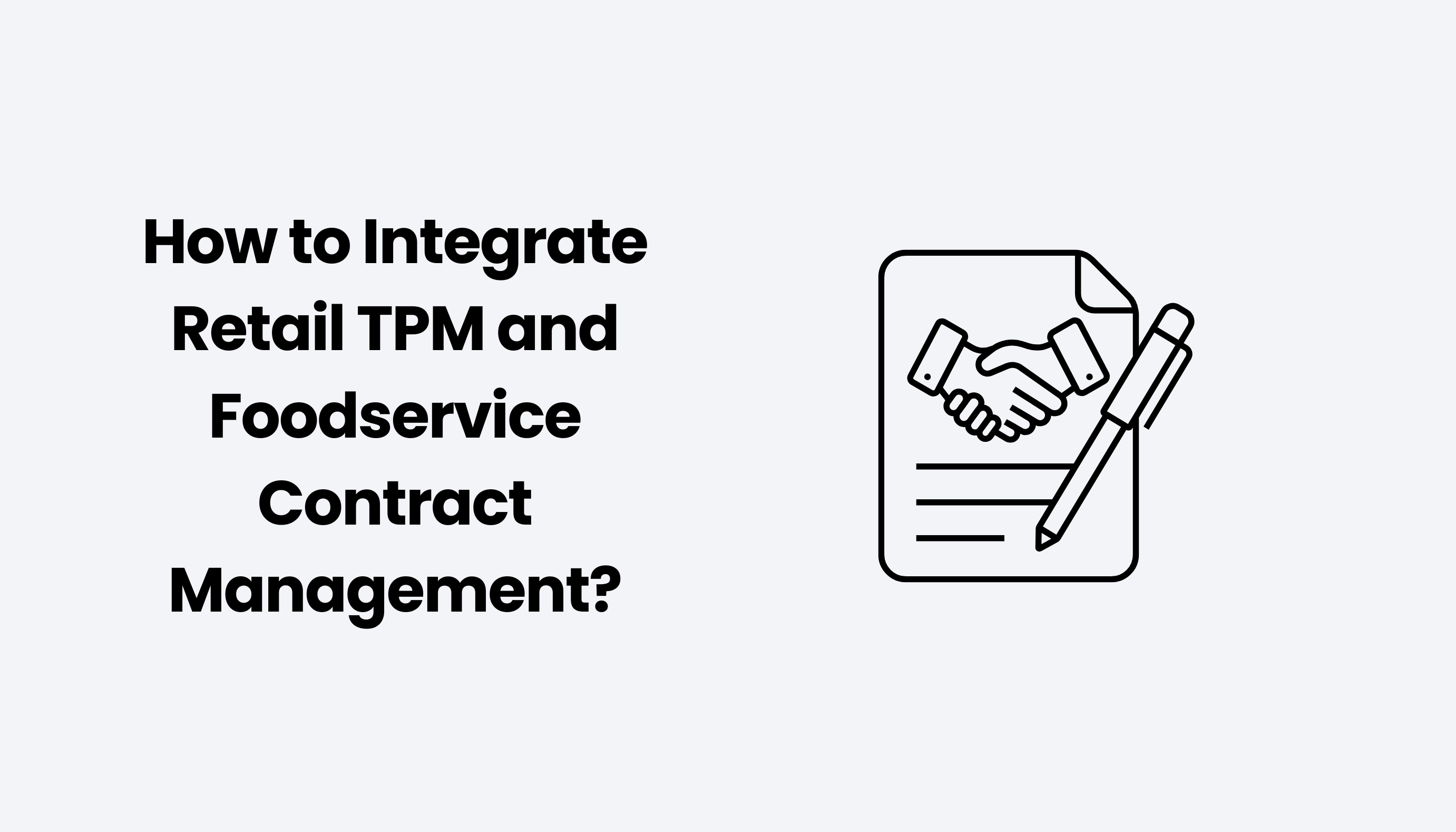
Managing trade promotions and contracts across retail and foodservice channels presents unique challenges for consumer goods manufacturers. While retail Trade Promotion Management (TPM) focuses on driving sales through discounts, merchandising, and promotions, foodservice contract management revolves around negotiated pricing, volume commitments, and sales incentives. Traditionally, these two areas have operated in silos due to their differing processes, terminologies, and data structures.
However, as more companies expand their presence in both retail and foodservice markets, the need for integrated management solutions has become crucial. Misaligned systems can lead to inefficiencies, inaccurate reporting, and missed opportunities for growth. This guide explores the key differences between retail TPM and foodservice contract management, the challenges of integrating the two, and strategies for implementing seamless solutions that improve operational efficiency and decision-making.
Table of Contents:
- What is Retail Trade Promotion Management (TPM)?
- What is Foodservice Contract Management?
- Comparative Analysis: Retail Trade Promotion Management (TPM) vs. Foodservice Contract Management
- Challenges in Integrating Retail and Foodservice Management
- Strategies for Effective Integration of Retail and Foodservice Management
- Implementing Integrated Solutions
- Future Trends and Considerations
Jump to a section that interests you, or keep reading.
What is Retail Trade Promotion Management (TPM)?
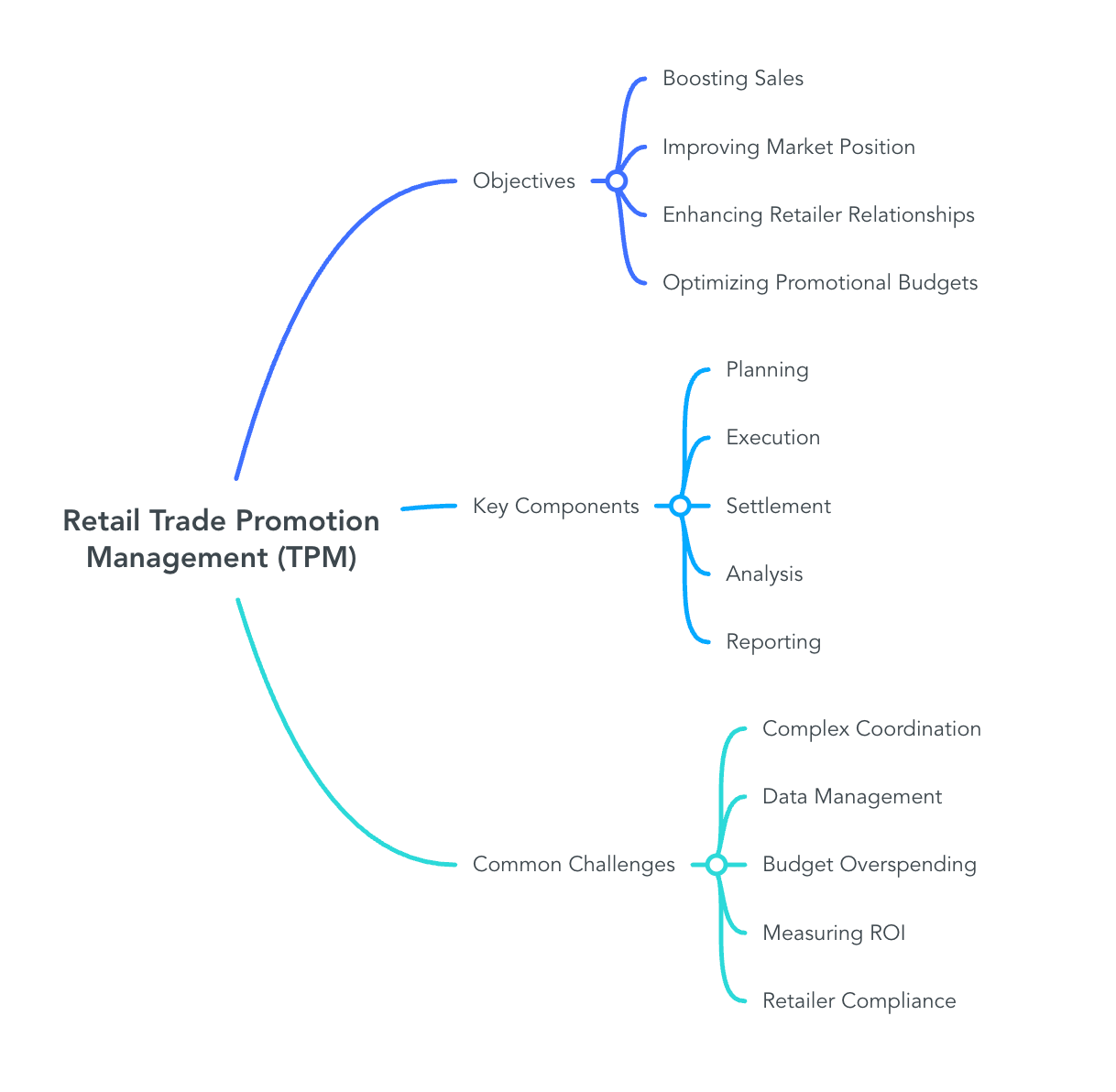
Retail Trade Promotion Management (TPM) is a structured approach used by consumer goods manufacturers to plan, execute, and analyze trade promotions within retail channels. The goal is to increase product sales, optimize promotional spending, and strengthen retailer partnerships.
Retail TPM involves managing marketing activities directed at retailers rather than consumers. The objectives include:
- Boosting Sales – Encouraging higher product turnover through promotions.
- Improving Market Position – Gaining a competitive advantage in the market.
- Enhancing Retailer Relationships – Strengthening collaboration for long-term success.
- Optimizing Promotional Budgets – Ensuring efficient use of promotional funds.
Key Components of Retail TPM
1. Planning
- Setting clear objectives for promotions.
- Allocating budgets efficiently.
- Designing promotions based on market trends.
2. Execution
- Coordinating with retailers to implement promotions.
- Ensuring sufficient inventory availability.
3. Settlement
- Processing financial claims related to promotions.
- Verifying expenses and resolving discrepancies.
4. Analysis
- Collecting data to assess promotional impact.
- Evaluating success based on key performance indicators (KPIs).
5. Reporting
- Documenting performance insights.
- Communicating findings to stakeholders for future improvements.
Common Challenges in Retail TPM
1. Complex Coordination: Managing multiple promotions across different retailers can lead to inconsistencies and misalignment.
2. Data Management: Accurate and real-time data collection is crucial but often difficult to achieve.
3. Budget Overspending: Without careful monitoring, promotional costs can exceed planned budgets.
4. Measuring ROI: Determining the exact impact of promotions on sales can be challenging due to multiple influencing factors.
5. Retailer Compliance: Ensuring retailers execute promotions as planned requires monitoring and enforcement mechanisms.
What is Foodservice Contract Management?
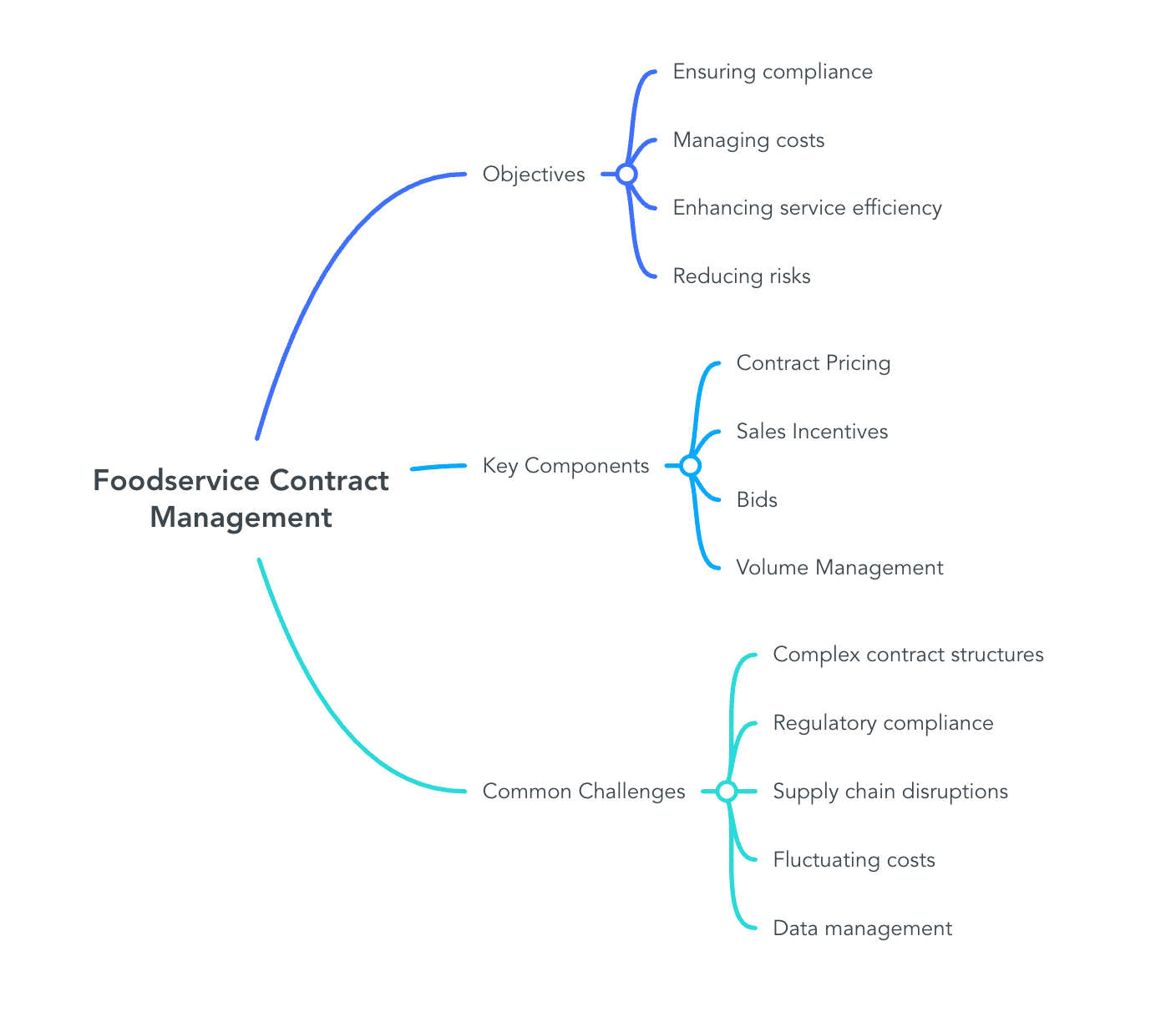
Foodservice contract management is the process of handling agreements between food manufacturers, distributors, and businesses that serve meals to consumers, such as restaurants, cafeterias, and institutional food providers. It ensures smooth transactions, adherence to terms, and profitability for all parties involved.
The main objectives include:
- Ensuring compliance with contract terms, regulatory requirements, and industry standards.
- Managing costs effectively while maintaining quality.
- Enhancing service efficiency to meet business demands and customer expectations.
- Reducing risks related to supply chain disruptions, price fluctuations, and contract disputes.
Key Components of Foodservice Contract Management
Contract Pricing
Pricing in foodservice contracts is structured differently than in retail. It often involves negotiated rates based on volume commitments, fluctuating ingredient costs, and special terms for long-term agreements. Prices may be adjusted based on external factors like market inflation, supply chain conditions, or changes in service scope.
Sales Incentives
Manufacturers and distributors offer various incentives to encourage higher sales and long-term commitments. These include performance-based rebates, volume discounts, and promotional pricing structures. Unlike retail promotions, these incentives are often tailored to the specific needs of foodservice buyers and are negotiated directly between parties.
Bids
Foodservice contracts are often awarded through a bidding process, where suppliers submit proposals to businesses or institutions seeking food products. Competitive bidding requires detailed cost breakdowns, proof of compliance with industry standards, and the ability to meet supply demands. Bids must also consider delivery logistics and service reliability to secure long-term agreements.
Volume Management
Unlike retail, where demand fluctuates based on consumer trends, foodservice contracts rely on steady volume commitments. Manufacturers must forecast demand accurately to manage production and inventory efficiently. Contracts typically define minimum and maximum volume commitments, ensuring a stable supply while allowing flexibility for seasonal or unexpected changes in demand.
Unique Challenges in Managing Foodservice Contracts
Managing foodservice contracts comes with specific challenges that differ from retail.
- Complex contract structures require handling multiple pricing models, rebates, and promotional agreements.
- Regulatory compliance varies across regions and industries, making it essential to stay updated with food safety laws and labeling requirements.
- Supply chain disruptions can impact order fulfillment, requiring backup sourcing strategies and contingency planning.
- Fluctuating costs for raw materials, transportation, and labor require contract terms that allow for pricing adjustments.
- Data management can be challenging, as tracking contract performance, rebates, and claims requires specialized software to prevent errors and inefficiencies.
Comparative Analysis: Retail Trade Promotion Management (TPM) vs. Foodservice Contract Management
Differences in Terminology and Processes
Retail Trade Promotion Management (TPM) focuses on short-term promotional activities designed to boost product sales through direct consumer engagement. Common terms include promotions, discounts, deductions, and scan events. The process involves planning promotional calendars, executing marketing campaigns, settling retailer deductions, and analyzing performance to refine future promotions.
Foodservice Contract Management, on the other hand, revolves around long-term agreements between manufacturers, distributors, and foodservice operators. It uses terms such as contracts, rebate programs, deviated pricing, and claims. The process includes negotiating contract terms, administering ongoing agreements, settling claims and rebates, and evaluating contract performance.
Variations in Planning and Execution Strategies
Retail TPM prioritizes short-term promotional strategies tailored to seasonal trends and consumer demand. Planning involves forecasting sales impact and aligning promotions with retailer schedules. Execution focuses on ensuring in-store promotions, digital marketing, and merchandising efforts are carried out effectively.
Foodservice Contract Management requires long-term strategic planning based on supply chain stability and pricing agreements. Planning involves volume commitments and service level expectations, while execution ensures accurate pricing, fulfillment of contractual obligations, and adherence to delivery schedules.
Distinct Settlement and Reporting Requirements
Settlement in retail TPM revolves around processing retailer deductions and reconciling promotional expenses. Reporting focuses on sales lift, return on investment, and consumer response using point-of-sale data.
Foodservice Contract Management settlement involves claim validation and rebate processing, ensuring payments are made according to contract terms. Reporting evaluates contract compliance, rebate effectiveness, and operational efficiency to optimize future agreements.
Challenges in Integrating Retail and Foodservice Management
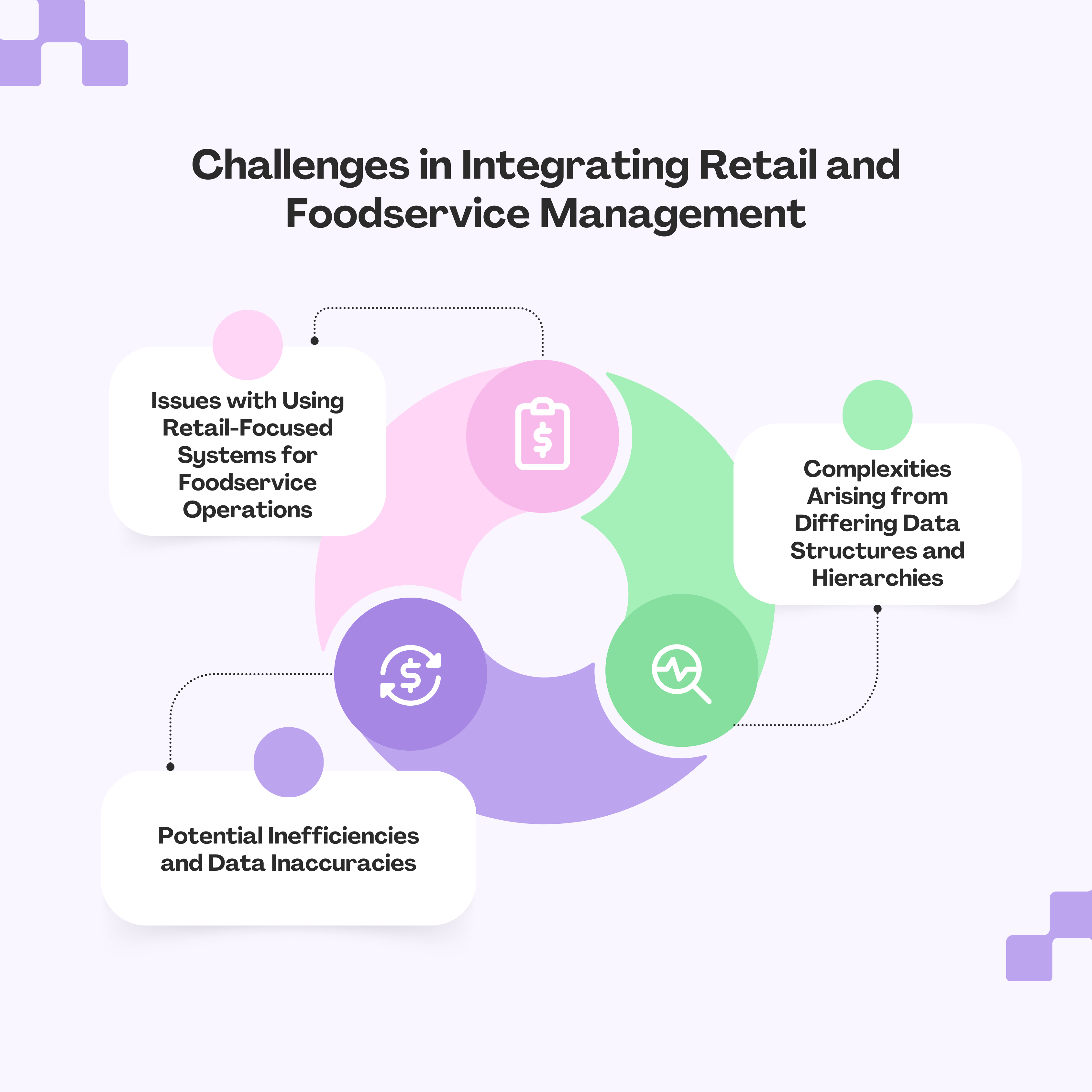
Integrating retail and foodservice management systems presents several challenges due to inherent differences in operations, data structures, and system requirements.
Complexities Arising from Differing Data Structures and Hierarchies
Retail and foodservice sectors operate with distinct data structures and organizational hierarchies. Retail systems often utilize hierarchical structures for reporting and analysis, requiring data allocation and storage at the lowest levels. This complexity can lead to challenges in data management and analysis.
In contrast, foodservice operations may involve different data organization methods, leading to complexities when attempting to integrate these systems. The differing data structures can result in challenges in data consistency and accuracy.
Issues with Using Retail-Focused Systems for Foodservice Operations
Implementing retail integration poses challenges due to the complexities of merging diverse systems, technologies, and processes. Using retail-focused systems for foodservice operations can lead to issues such as incompatibilities, data silos, inefficiencies, and a poor customer experience.
Potential Inefficiencies and Data Inaccuracies
The integration of retail and foodservice management systems can lead to inefficiencies and data inaccuracies if not properly managed. Challenges such as data silos, inefficiencies, and a poor customer experience can arise from incompatibilities between systems.
Strategies for Effective Integration of Retail and Foodservice Management
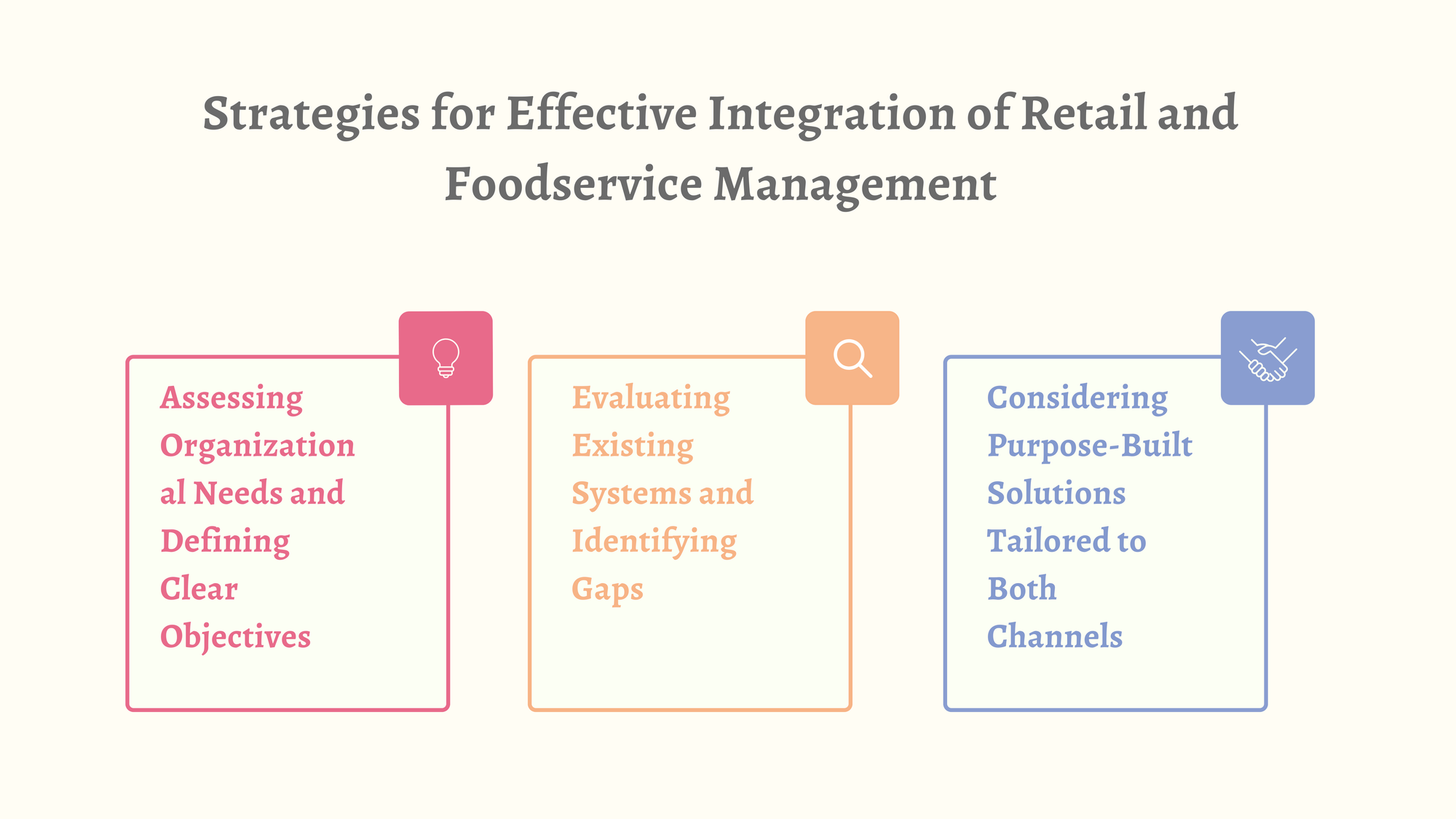
Integrating retail and foodservice operations requires a comprehensive approach to ensure seamless functionality and enhanced customer experiences. The following strategies outline critical steps for effective integration.
Assessing Organizational Needs and Defining Clear Objectives
Begin by thoroughly evaluating your organization's current operations to identify specific needs and integration goals. This assessment should encompass both retail and foodservice components, considering factors such as inventory management, sales processes, customer engagement, and technological infrastructure. Engage stakeholders from all relevant departments to gather diverse perspectives and ensure alignment with the company's strategic vision. Clearly defined objectives will guide the integration process and serve as benchmarks for measuring success.
Evaluating Existing Systems and Identifying Gaps
Conduct a detailed analysis of your current systems, including Point of Sale (PoS) systems, Enterprise Resource Planning (ERP) platforms, Customer Relationship Management (CRM) tools, and other relevant technologies. Identify any redundancies, inefficiencies, or incompatibilities that may hinder integration. For instance, disparate PoS systems in retail and foodservice operations can lead to fragmented data and operational challenges. Recognizing these gaps is essential for developing a cohesive integration plan.
Considering Purpose-Built Solutions Tailored to Both Channels
To address the unique requirements of both retail and foodservice operations, consider implementing purpose-built solutions designed to harmonize these channels. Integrated PoS systems that bridge the gap between various business applications can enhance sales tracking, inventory control, staff management, and customer interactions. Additionally, adopting ERP systems that streamline store management processes, including inventory oversight, order tracking, and PoS integration, can optimize operations across both sectors. These tailored solutions facilitate a unified approach, ensuring that both retail and foodservice components operate efficiently and cohesively.
Implementing Integrated Solutions
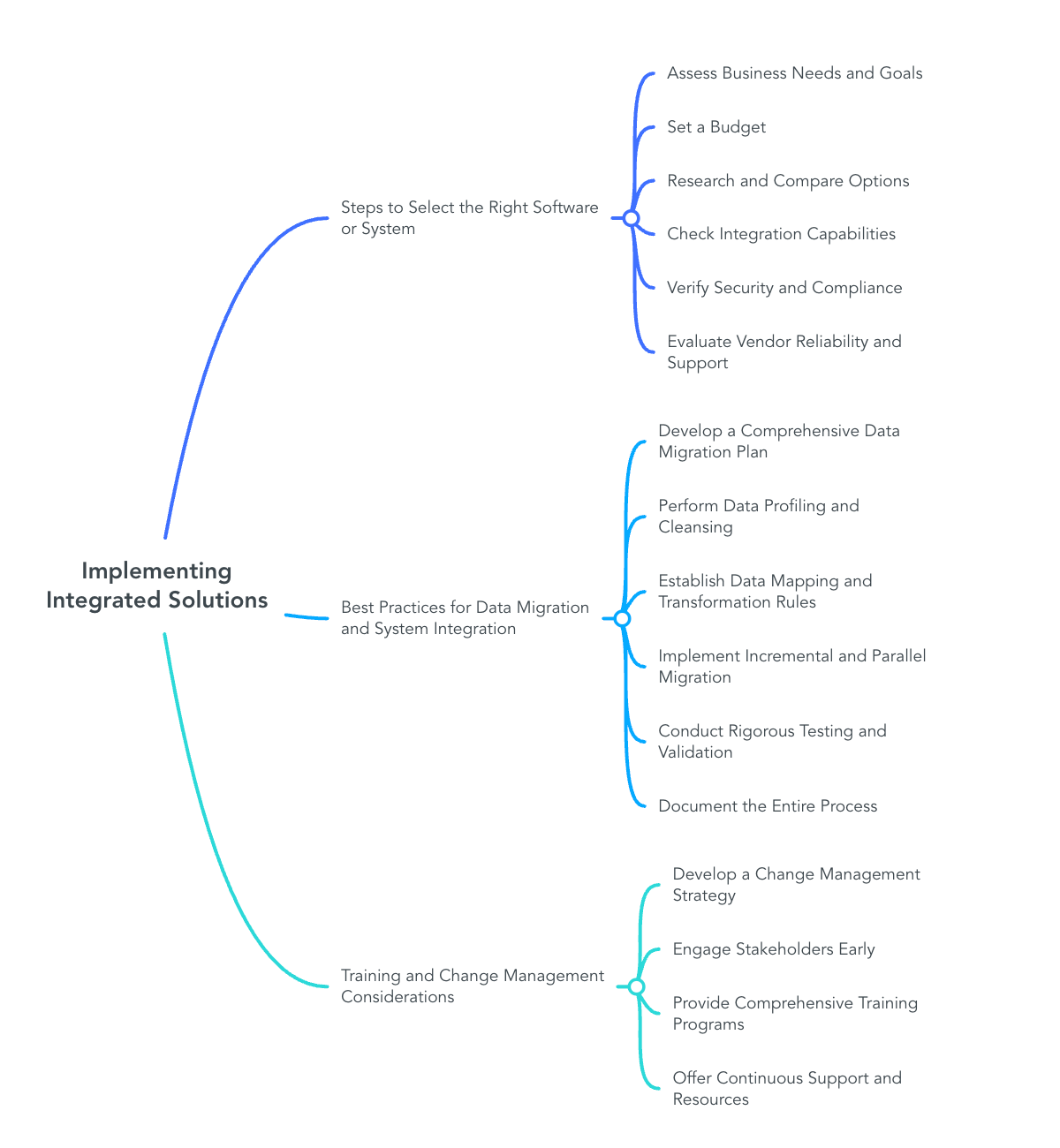
Integrating retail and foodservice management systems is a multifaceted process that demands careful planning and execution. The following sections outline the critical steps and considerations to ensure a successful integration.
Steps to Select the Right Software or System
-
Assess Business Needs and Goals: Begin by thoroughly evaluating your organization's current operations to identify areas requiring improvement, such as inventory tracking, customer engagement, or sales processes. This assessment should involve input from various departments to ensure a comprehensive understanding of the organization's needs.
-
Set a Budget: Determine the financial resources available for the integration project. A clear budget helps narrow down options and prevents overspending.
-
Research and Compare Options: Investigate various software solutions that cater to both retail and foodservice operations. Compare features, scalability, user-friendliness, and vendor reputation to identify systems that align with your business objectives.
-
Check Integration Capabilities: Ensure the selected software can seamlessly integrate with existing systems, such as Point of Sale (PoS) systems, Enterprise Resource Planning (ERP) platforms, and Customer Relationship Management (CRM) tools. Compatibility is crucial for data consistency and operational efficiency.
-
Verify Security and Compliance: Confirm that the software adheres to industry security standards and complies with relevant regulations to protect sensitive data and maintain customer trust.
-
Evaluate Vendor Reliability and Support: Assess the vendor's track record, customer reviews, and support services. A reliable vendor provides ongoing assistance, updates, and training resources essential for long-term success.
Best Practices for Data Migration and System Integration
-
Develop a Comprehensive Data Migration Plan: Outline the scope, objectives, timelines, and resources required for data migration. A detailed plan serves as a roadmap, guiding the project from inception to completion.
-
Perform Data Profiling and Cleansing: Analyze the quality of existing data to identify inconsistencies, duplicates, or errors. Clean data ensures accuracy and reliability in the new system.
-
Establish Data Mapping and Transformation Rules: Define how data from legacy systems will translate into the new system's structure. Clear mapping prevents data loss and maintains integrity during migration.
-
Implement Incremental and Parallel Migration: Instead of migrating all data at once, consider phased approaches that run parallel systems temporarily. This strategy minimizes risks and allows for validation at each stage.
-
Conduct Rigorous Testing and Validation: Before full deployment, perform extensive testing to verify that data migration and system integration meet all functional and performance requirements. Testing identifies potential issues that can be addressed proactively.
-
Document the Entire Process: Maintain detailed records of methodologies, configurations, and decisions made during the migration. Documentation serves as a reference for future projects and aids in troubleshooting.
Training and Change Management Considerations
-
Develop a Change Management Strategy: Recognize that system integration impacts organizational culture and workflows. A structured change management plan addresses potential resistance, aligns stakeholders, and fosters a supportive environment for transition.
-
Engage Stakeholders Early: Involve employees from various levels in the planning stages to gather insights, address concerns, and build ownership of the new system. Early engagement facilitates smoother adoption.
-
Provide Comprehensive Training Programs: Equip staff with the necessary skills to operate the new system effectively. Tailored training sessions ensure that employees are confident and competent, reducing errors and enhancing productivity.
-
Offer Continuous Support and Resources: Establish channels for ongoing assistance, such as help desks or online resources, to address post-implementation challenges. Continuous support ensures that employees can adapt to the new system and maintain operational efficiency.
Future Trends and Considerations
The space of Trade Promotion Management (TPM) is undergoing significant transformation, driven by technological advancements, evolving consumer behaviors, and shifting distribution channels. To navigate this dynamic environment, organizations must understand and adapt to these emerging trends.
The Role of Technology and Automation in Integrated TPM Solutions
Technology and automation are revolutionizing TPM by streamlining processes, enhancing accuracy, and providing actionable insights. Key developments include:
-
Advanced Analytics and Artificial Intelligence (AI): AI-powered systems analyze vast datasets to forecast sales trends, optimize promotional strategies, and personalize consumer engagements. These technologies enable more precise targeting and efficient resource allocation.
-
Robotic Process Automation (RPA): RPA automates repetitive tasks such as data entry and reconciliation, reducing manual errors and freeing up human resources for strategic activities. For example, Infosys BPM implemented RPA in a leading consumer goods company's TPM system, resulting in improved efficiency.
-
Integrated Software Platforms: Comprehensive TPM solutions integrate various functions—budgeting, promotion planning, execution, and reporting—into a unified system. This integration facilitates real-time data sharing and collaboration across departments, leading to more cohesive strategies.
-
Automation in Retail Operations: Retailers are increasingly adopting automation technologies to enhance efficiency and reduce labor costs. Innovations such as electronic shelf labels, self-service kiosks, and robotic warehouse systems are becoming commonplace. For instance, UK retailers have embraced automation to streamline operations and cut staffing expenses.
Emerging Trends in Consumer Goods Distribution Channels
The distribution landscape for consumer goods is evolving, influenced by technological advancements and changing consumer preferences. Notable trends include:
-
E-commerce Expansion: The convenience and accessibility of online shopping have led to a significant shift from traditional retail to e-commerce platforms. Businesses are investing in robust online infrastructures to cater to this growing demand.
-
Omnichannel Strategies: Consumers expect seamless experiences across multiple channels—online, mobile, and in-store. Integrating these channels ensures consistent engagement and satisfaction.
-
Direct-to-Consumer (DTC) Models: Brands are increasingly bypassing traditional retail intermediaries to sell directly to consumers, allowing for greater control over branding, pricing, and customer relationships.
-
Technological Integration in Distribution: Automation and AI are optimizing distribution processes, enhancing efficiency, and reducing costs. For example, Target has revamped its grocery supply chain by opening new food-distribution centers to better manage inventory and meet consumer demand.
Preparing for Future Challenges and Opportunities in Integrated Management
To thrive in this evolving environment, organizations should consider the following strategies:
-
Adopt Advanced Technologies: Investing in AI, machine learning, and automation can enhance decision-making and operational efficiency.
-
Develop Omnichannel Capabilities: Ensuring a seamless customer experience across all channels can strengthen brand loyalty and drive sales.
-
Enhance Data Analytics: Leveraging data analytics provides insights into consumer behaviors and market trends, informing more effective promotional strategies.
-
Focus on Sustainability: Implementing sustainable practices can meet consumer expectations and comply with regulatory requirements, potentially reducing costs and enhancing brand reputation.
-
Foster Agility: Building a flexible organizational structure enables rapid adaptation to market changes and emerging opportunities.
Conclusion
As consumer goods manufacturers continue to navigate an evolving market, integrating retail TPM and foodservice contract management is no longer optional—it’s essential for maintaining competitiveness. By leveraging advanced technologies, purpose-built systems, and data-driven insights, companies can streamline operations, enhance financial accuracy, and optimize trade spending.
The future of integrated management will be shaped by automation, AI-driven analytics, and the rise of omnichannel distribution strategies. Businesses that proactively invest in these innovations will be better positioned to manage complexity, improve collaboration, and drive long-term growth across both retail and foodservice sectors.
